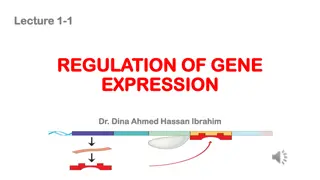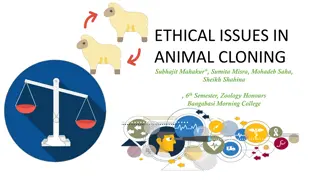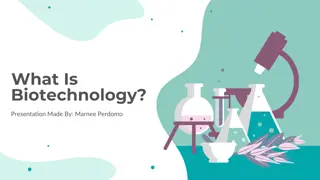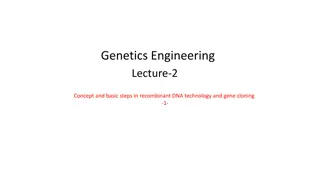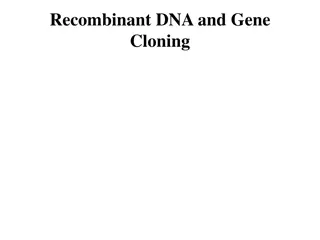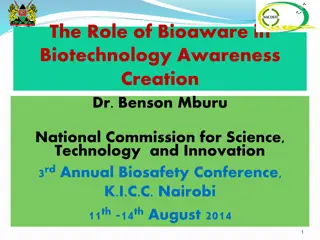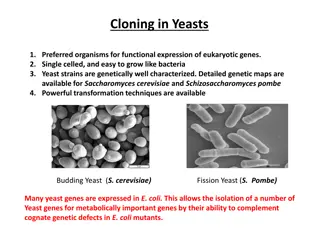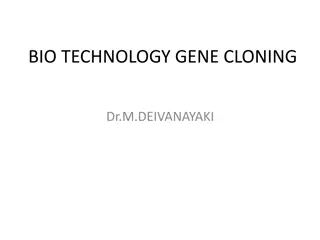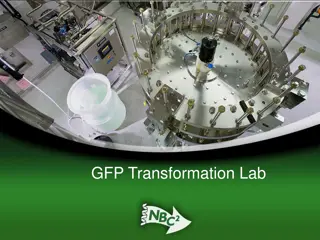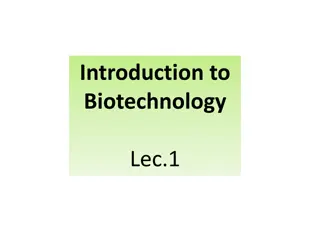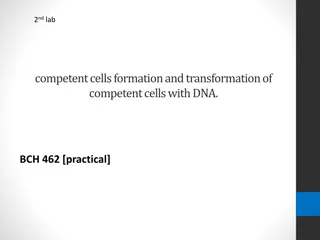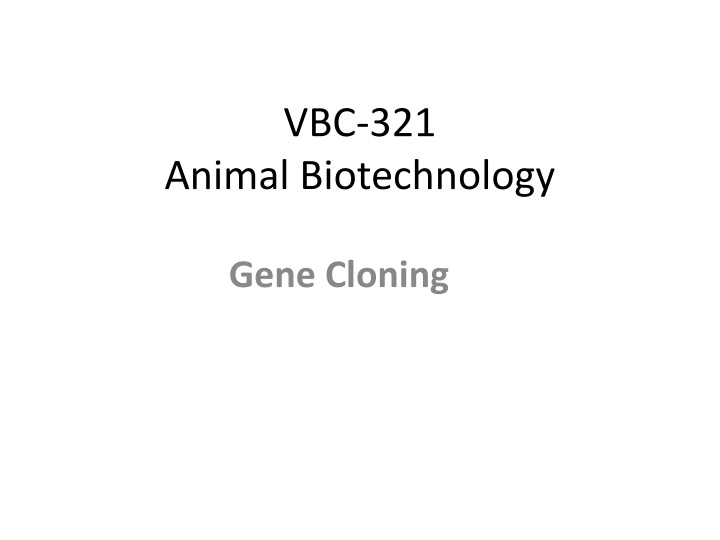
Animal Biotechnology: Gene Cloning Techniques and Transformation Methods
This content covers gene cloning processes including enzymes used, requirements, bacterial transformation methods like chemical transformation with calcium chloride and transformation by electroporation. It also explains transfection in eukaryotic cells.
Download Presentation

Please find below an Image/Link to download the presentation.
The content on the website is provided AS IS for your information and personal use only. It may not be sold, licensed, or shared on other websites without obtaining consent from the author. If you encounter any issues during the download, it is possible that the publisher has removed the file from their server.
You are allowed to download the files provided on this website for personal or commercial use, subject to the condition that they are used lawfully. All files are the property of their respective owners.
The content on the website is provided AS IS for your information and personal use only. It may not be sold, licensed, or shared on other websites without obtaining consent from the author.
E N D
Presentation Transcript
VBC-321 Animal Biotechnology Gene Cloning
Requirement for Gene Cloning Enzymes Insert DNA Vector Host cell
Enzymes used in gene cloning Restriction endonuclease- cut the DNA at Specific site, these of often known as molecular scissor DNA ligase- joining of two DNA molecule, often known as molecular glue Reverse transcriptase- use to produce cDNA from mRNA Alkaline phosphatase- for removing 5 phosphorus from DNA ends. T4 Polynucleotide kinase- for addition of phosphate group to an end having a free 5 - OH
S1 protrusions from ends, both 3 and 5 protrusion are removed Klenow fragment of E. coli DNA polymerase I- to make the protruding ends double stranded by extending the shorter strands Lambda Exonuclease- for removal of nucleotide from 5 ends Exonuclease III- for removal of nucleotides from 3 end Terminal deoxynucleotidyl addition of single stranded sequence to 3 end of blunt ended fragment nuclease- for removal of single stranded transferase- for
Bacterial transformation Transformation is processes by which exogenous genetic material may be introduced into a bacterial cell Methods Chemical method Electroporation
CHEMICAL TRANSFORMATION WITH CALCIUM CHLORIDE
TRANSFECTION Transfection is the process of introducing nucleic acids into eukaryotic cells by using carrier molecules Animal cells are transfected by opening transient pores or holes in the cell membrane to allow the uptake of material Genetic material such as plasmid DNA or siRNA constructs or proteins such as antibodies may be transfected into cells Transfection may cause changes in morphology of target cells
METHODS Calcium Phophate method : One of the cheapest methods of transfection is by calcium phosphate. HEPES-buffered saline solution containing phosphate ions is combined with a calcium chloride solution containing the DNA to be transfected Mixing of these two results in precipitate due to binding of positively charged calcium and the negatively charged phosphate This suspension of precipitate is then added to the cells to be transfected, usually a cell culture grown in a monolayer The cells take up some of the precipitate and the DNA
Liposome method : It is a very efficient method of transfection. Liposomes, a small, membrane-bounded body that are in similar to the structure of a cell and can actually fuse with the cell membrane The DNA to be transfected is trapped into the liposomes This DNA loaded liposome is added to the cells to be transfected and release the DNA into the cell
PLASMID CLONING STRATEGY Involves five steps: Enzyme restriction digest of DNA sample. Enzyme restriction digest of DNA plasmid vector. Ligation of DNA sample products and plasmid vector. Transformation with the ligation products. Growth on agar plates with selection for antibiotic resistance.
STEP 1. RE DIGESTION OF DNA SAMPLE
STEP 2. RE DIGESTION OF PLASMID DNA
STEP 3. LIGATION OF DNA SAMPLE AND PLASMID DNA
STEP 4. TRANSFORMATION OF LIGATION PRODUCTS The process of transferring exogenous DNA into cells is call transformation There are basically two general methods for transforming bacteria. The first is a chemical method utilizing CaCl2 and heat shock to promote DNA entry into cells. A second method is called electroporation based on a short pulse of electric charge to facilitate DNA uptake.
STEP 5. GROWTH ON AGAR PLATES
STEP 5 Blue colonies represent Ampicillin-resistant bacteria that contain pVector and express a functional alpha fragment from an intact LacZ alpha coding sequence. White colonies represent Ampicillin-resistant bacteria that contain pInsert and do not produce LacZ alpha fragment
BLUE/WHITE SCREENING Colony Selection: finding the rare bacterium with recombinant DNA Only E. coli cells with resistant plasmids grow on antibiotic medium Only plasmids with functional lacZ gene can grow on Xgal lacZ(+) => blue colonies lacZ functional => polylinker intact => nothing inserted, no clone lacZ(-) => white colonies polylinker disrupted => successful insertion & recombination!
-complementation The portion of the lacZ gene encoding the first 146 amino acids (the -fragment) are on the plasmid The remainder of the lacZ gene is found on the chromosome of the host. If the -fragment of the lacZ gene on the plasmid is intact (that is, you have a non- recombinant plasmid), these two fragments of the lacZ gene (one on the plasmid and the other on the chromosome) complement each other and will produce a functional - galactosidase enzyme.
SCREENING RECOMBINANTS In the example shown above, the b-galactosidase gene is inactivated. The substrate "X-gal" turns blue if the gene is intact, ie. makes active enzyme. White colonies in X-gal imply the presence of recombinant DNA in the plasmid.


